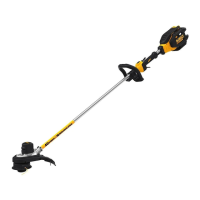7
English
d. If charging problems persist, take the appliance, battery pack
and charger to your local service center.
5. The battery pack should be recharged when it fails to produce
sufficient power on jobs which were easily done previously. DO
NOT CONTINUE to use under these conditions. Follow the
charging procedure. You may also charge a partially used pack
whenever you desire with no adverse effect on the battery pack.
6. Foreign materials of a conductive nature such as, but not limited
to, grinding dust, metal chips, steel wool, aluminum foil, or any
buildup of metallic particles should be kept away from charger
cavities. Always unplug the charger from the power supply when
there is no battery pack in the cavity. Unplug the charger before
attempting to clean.
7. Do not freeze or immerse the charger in water or any other liquid.
WARNING: Shock hazard. Don’t allow any liquid
to get inside the charger. Electric shock may result.
WARNING: Burn hazard. Do not submerge the
battery pack in any liquid or allow any liquid to enter the battery pack.
Never attempt to open the battery pack for any reason. If the plastic
housing of the battery pack breaks or cracks, return to a service center
for recycling.
Storage Recommendations
1. The best storage place is one that is cool and dry, away from direct
sunlight and excess heat or cold.
2. For long storage, it is recommended to store a fully charged battery
pack in a cool dry place out of the charger for optimal results.
NOTE: Battery packs should not be stored completely depleted of
charge. The battery pack will need to be recharged before use.
SAVE THESE INSTRUCTIONS
LEAVING THE BATTERY PACK IN THE CHARGER
The charger and battery pack can be left connected with the charge
indicator showing Pack Charged.
WEAK BATTERY PACKS: Weak batteries will continue to function
but should not be expected to perform as much work.
FAULTY BATTERY PACKS: This charger will not charge a faulty
battery pack. The charger will indicate faulty battery pack by refusing
to light or by displaying problem pack or charger.
NOTE: This could also mean a problem with a charger.
Important Charging Notes
1. Longest life and best performance can be obtained if the battery
pack is charged when the air temperature is between 65 °F and
75 °F (18 ° – 24 °C). DO NOT charge the battery pack in an air
temperature below +40°F (+4.5°C), or above +105°F (+40.5°C).
This is important and will prevent serious damage to the battery pack.
2. The charger and battery pack may become warm to the touch
while charging. This is a normal condition, and does not indicate
a problem. To facilitate the cooling of the battery pack after use,
avoid placing the charger or battery pack in a warm environment
such as in a metal shed or an uninsulated trailer.
3. A cold battery pack will charge at about half the rate of a warm
battery pack. The battery pack will charge at that slower rate
throughout the entire charging cycle and will not return to
maximum charge rate even if the battery pack warms.
4. If the battery pack does not charge properly:
a. Check operation of receptacle by plugging in a lamp or other
appliance;
b. Check to see if receptacle is connected to a light switch which
turns power off when you turn out the lights;
c. Move the charger and battery pack to a location where the
surrounding air temperature is approximately 65 °F – 75 °F
(18° – 24°C);

